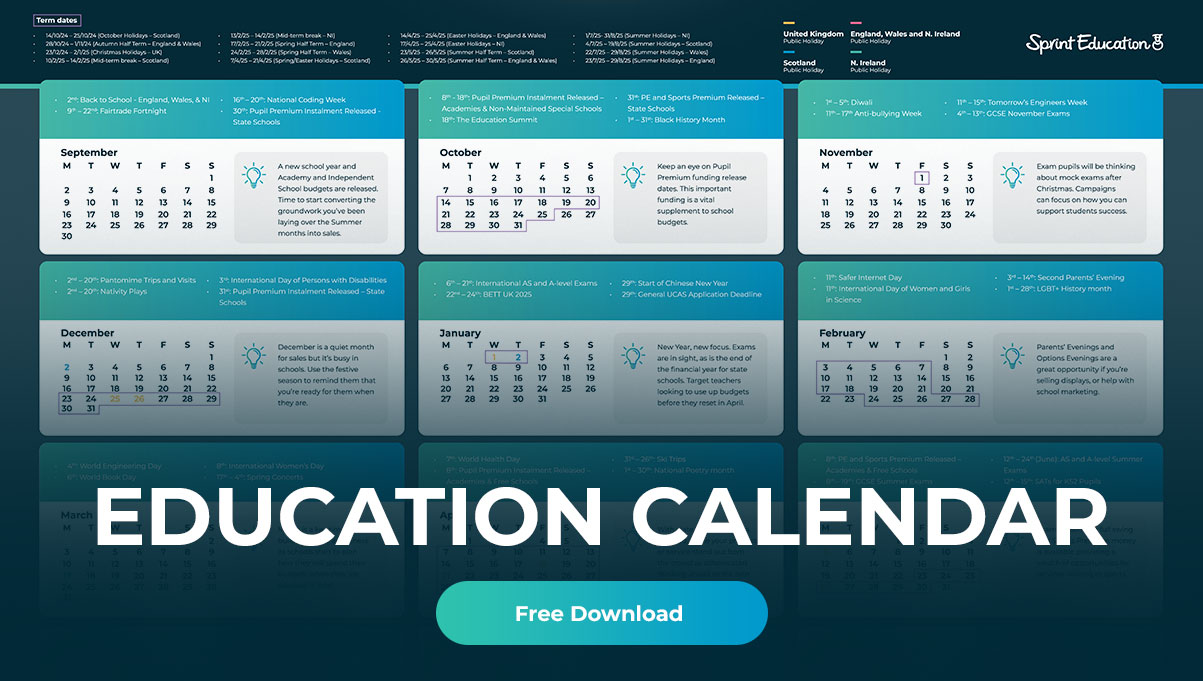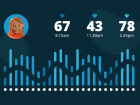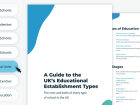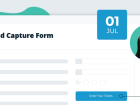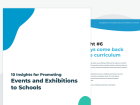State of Selling to Schools 2022 (Part 1)
State of Selling to Schools 2022 (Part 1)
Explore insights into schools’ problems and their priorities for the year ahead.
Explore insights into schools’ problems and their priorities for the year ahead.
At the end of 2020, we conducted our most in-depth education survey ever, capturing insights from over 2,600 teachers and school staff via social media and email channels.
The purpose of the survey was to learn from the state of selling to schools and how COVID-19 had impacted the sector to inform our response to the ongoing pandemic and the shifting needs of schools, pupils, teachers, and school staff.
One year on, and we’re not out of the woods yet.
While the start of the new academic year in September 2021 held a renewed hope for some normality, by late December, cases of the Omicron variant were rising rapidly, Bett 2022 was postponed, and the start of 2022 once again became unpredictable.
Why read this report?
This year’s report is even bigger!
With 3,210 responses from teachers and school staff, the report is designed to help you navigate this difficult edu-marketing period.
The report combines insights into schools’ problems and priorities for the year ahead and draws comparisons with last year’s survey results, where applicable, to help you shape your marketing strategy, solve schools’ problems, and make more sales.
Chapter 1 - Who completed our survey?
Which best describes your role?

Teachers made up 32.7% of our total number of respondents, offering a unique insight into the thoughts and opinions of school staff at the forefront of day to day school activity and pupil engagement – and often the core audience for selling to school marketing campaigns.
There was also a large response rate from Heads of Departments, Years, and Key Stages (32.3%) and Senior Leaders (19%). These roles are the key decision-makers regarding budget spend at their schools and are in a position to be able to give a more rounded overview of how their school has fared over the last year.
Which type of establishment do you work in?
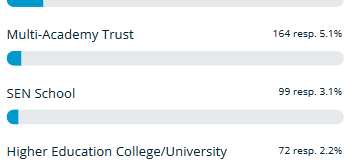
As expected, the largest response came from Primary and Secondary establishments. With 1,170 responses from Secondary School staff (Academy and State School) and just behind, Primary School staff (Academy and State School) supplied 1,078 responses.
The wide range of survey responses received will give you a good overview of the thoughts and feelings of school staff working at every level and across a range of establishment types to help identify schools’ very top priorities for 2022 and tailor your strategy design for maximum impact.
Chapter 2 – Communicating with schools
The crucial question for businesses is how to let teachers know what they’re offering. We promoted the survey online via social media and email to ask the question:
Which method of receiving communications and offers from education businesses are you most likely to reply/react to?
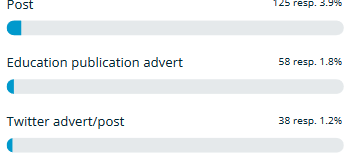
91.4% of teachers surveyed said that email was the method of communication from education businesses they were most likely to reply/react to.
This increased from 88.3% from last year.
Here at Sprint Education, we know the value of email marketing to the education sector over other methods of communication. Still, we were surprised to see such a definitive outcome for email communication.
We know that teachers have been spending more time online during the pandemic than they usually would and are two times more likely to check their inboxes than usual.
Email communication is an effective but unobtrusive way to engage with teachers. We only ever email teachers work email accounts about products and services that will benefit their school. The benefit of emailing work-only addresses is that teachers actively need to log into their work account. They will be expecting emails related to their job, and they will likely be in the right frame of mind to engage with this kind of content.
Emails are also quick to delete, and all emails sent by Sprint Education are simple to unsubscribe from – it just takes two clicks for a teacher to remove themselves from all our future communications. The option to quickly opt-out isn’t as simple for all the other communication methods listed, particularly social media.
While social media campaigns can be highly effective, it’s clearly the least favoured method of communication for teachers, with communication via Twitter, Facebook, and LinkedIn receiving less than 3% of combined survey responses.
Social media is mostly used by people to connect with friends and family. Therefore, it’s less likely that teachers will be as keen to engage with marketing messages when not in work mode.
How often do you check these social/communication tools each day?
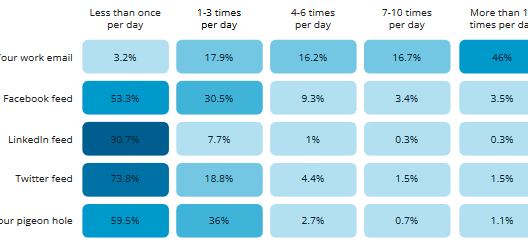
The preference for email communication is made even more apparent here.
46% of teachers surveyed said they check their work email more than ten times a day.
Facebook is the second communication tool that teachers engage with most regularly, but it trails far behind email, with just 3.5% of teachers saying they check it more than ten times a day.
Delving deeper into our survey response stats, we can see an average of 8.3 inbox views per day and 2.7 Facebook views per day. That’s 303% more email inbox views than Facebook views per day. Applied across the whole UK sector, this equates to 5,291,400 more inbox logins than Facebook logins by UK teachers every day - 1.9 billion more over one academic year!
Of course, teachers will be checking their inboxes for work emails. They may not pay marketing emails the same level of attention they pay to a message from a colleague. However, if you can highlight how important your offer is concerning their day-to-day work, your email is bound to gain attention.
While 59.5% of teachers said they only check their pigeon-hole once a day, we need to remember that this is quite a different method of communication.
Checking a pigeon-hole once a day is not the same as scrolling a Twitter feed once a day. The power of something that can be held in the palm of your hand cannot be underestimated.
If your pigeon-hole mail captures the recipients' imagination, teachers are likely to engage with it on a far deeper level.
How likely are you to react positively to the following calls to action within a communication sent to you from an education service provider?
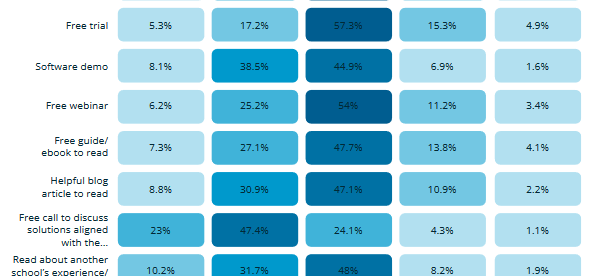
The clear preference here was for a free trial or a free guide/ebook with 4.9% and 4.1%, respectively, saying they’d ‘definitely’ react positively to these offers.
These call to actions require no commitment from the teacher. They just offer them free value. When you’re trying to reach new customers and capture their attention, you have to make engaging with your email worth their time.
If you’re wondering what on earth you get out of giving away freebies, you can use this tactic to collect their contact details to contact them again at a later date. Offering helpful, free information helps you build good relationships with teachers and school staff, positioning yourself as a valuable, expert provider.
The offer of a free call to discuss solutions received a ‘definitely not’ from a huge 23% of surveyed teachers. While this call to action may be crucial for moving them along your sales funnel, it’s important not to rush to this stage too quickly.
Ideally, you want to warm them up to your offer first by giving them an easy and enticing reason for them to engage, and keep the free call for later on in your strategy once they know it’ll be worth their time.
The results on communicating with schools are conclusive – email is the preferred method of communication for teachers and school staff. Emails offer teachers a snapshot of the products or services they may need, saving them hours of research and time spent on Google.
However, teachers can decide whether to engage with them or not.
The key to them engaging in your outreach email is to offer them value for little commitment. Try a free trial or a free guide or ebook to get them interested. Once you’ve captured their attention and their contact details, any future emails offering a free call to discuss solutions will likely be met more positively.
Chapter 3 – Connecting with schools
Once you’ve been able to engage a teacher with your marketing, you need to know when and how to continue the conversation.
To help you make those all-important meetings happen, we asked the all-important questions.
When is the most convenient time for you to be able to connect with an education supplier?
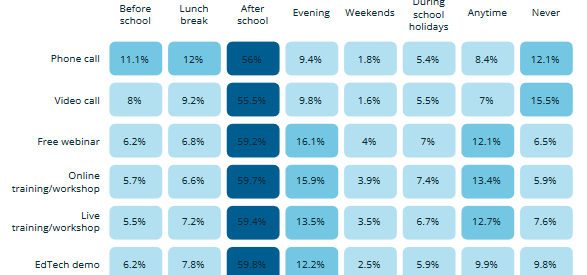
The overwhelming response here for every method of communication, from a phone call to a demo, was ‘After School’.
Teachers have packed schedules from the second they arrive at school in the morning to the moment the final bell rings and pupils have left the grounds. Unsurprisingly, they feel that they can’t give anything other than their pupils their attention during the school day.
However, their willingness to engage in the ‘Evening’ dropped sharply. 56% of surveyed teachers said that the most convenient time for a phone call would be ‘After School’, but only 9.4% said the most convenient time would be in the ‘Evening’.
Therefore, there’s a sweet spot between the usual daily lessons and the time that teachers consider the working day as done.
Although during COVID-19 restrictions there were staggered school hours, most schools start between 8:30 and 9 am and finish between 3 pm and 3:45.
The hours between 4 pm and 6 pm are likely to be the sweet spot between ‘After School’ and ‘Evening’, and, therefore, the best time for hosting webinars, meetings, demos, and workshops.
How much notice should be given by an education supplier for you to best consider their offer of…?
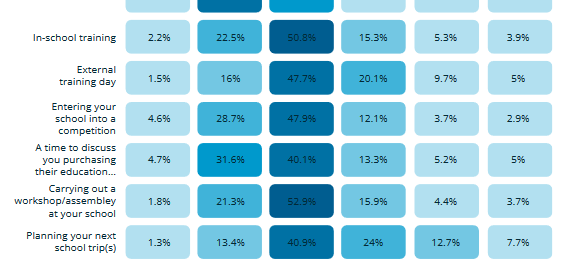
The vast majority of teachers said 1-3 months for offers that require more time commitment and preparation, such as planning a school trip, an external or internal training day, or a workshop or assembly in their school.
Entering their school in a competition also gained the most responses (47.9%) for 1-3 months of notice. For a whole-school competition, teachers would likely need to get the approval of multiple staff members and, potentially, parents. Smaller class competitions probably wouldn’t require as much notice.
Teachers said that the offers that require less preparation, such as a free webinar or watching an EdTech demo, ideally need 2-4 weeks’ notice.
When it comes to purchasing decisions, the vast majority of surveyed teachers (71%) said they’d require between 2 weeks and 3 months’ notice. Again, most purchasing decisions will require the buy-in of more than one member of staff.
To ensure better relationships with teachers, you need to be mindful of their working patterns.
Your webinar could promise to reveal the secret to a guaranteed Outstanding Ofsted inspection, but if you scheduled it for 10am on a Tuesday in the middle of term time, most of your audience would have to miss it.
We all know that teachers are exceptionally busy, so give them plenty of time to make decisions.
This is where a strategy of at least three emails is vital rather than a single email. It’s always best to alert your audience to your offer early, make sure they have all details, and finally follow them up with a reminder.
Tags
Education News
How to Sell to Schools
How to Sell to Teachers
Selling to Schools
Selling to Teachers
Similar Articles
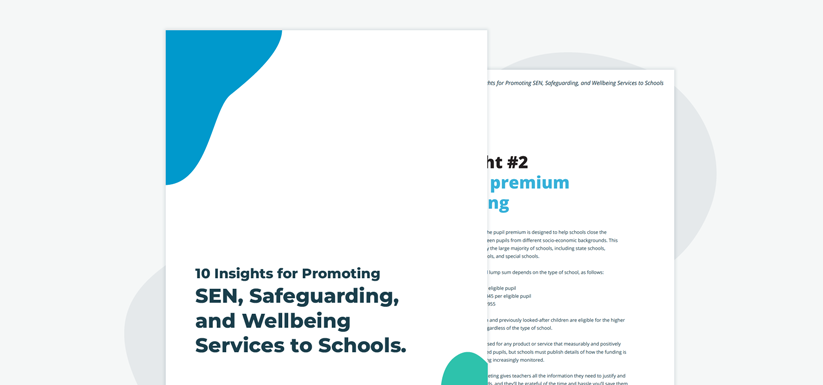

Marketing SEN, Safeguarding, and Wellbeing Services
Learn 10 game-changing insights especially for school SEN, Safeguarding, and Wellbeing providers to enhance your edu-marketing email campaigns.
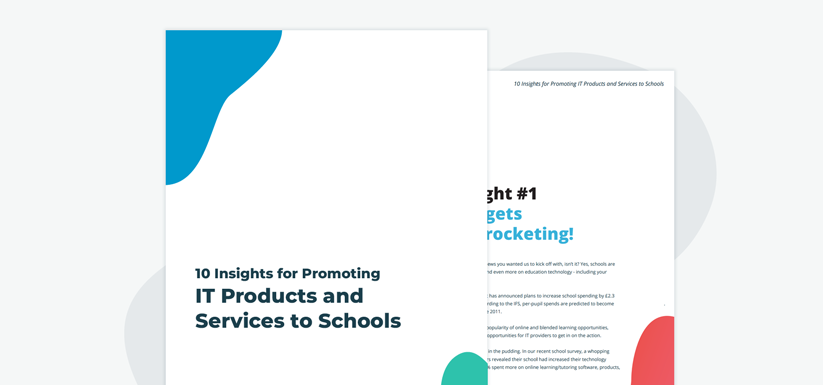

Marketing IT Products and Services to Schools
Learn 10 game-changing insights especially for IT product and service providers to enhance your education marketing campaigns when emailing schools.


Expert marketing to schools support and solutions
Expert marketing to schools solutions
Email Head Teachers, Teachers, and Staff Inboxes
Email teachers and staff inboxes
Sell More to UK and Global Schools and Colleges
Sell more to schools and colleges

















